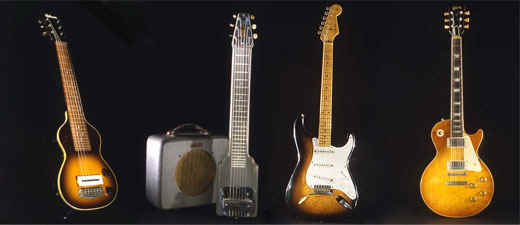

Gibson ES-150
Gibson Inc.
Kalamazoo, Michigan
Around 1937

Introduced in 1936, this was the first Spanish-style electric guitar to
achieve commercial significance, thanks in part to Charlie Christian, an inventive jazz
soloist who gained prominence with the Benny Goodman Sextet. Christian took what had been
considered a novelty and brought it to the forefront as a lead instrument.
Gibson's first electric Spanish guitar, the ES-150's design featured a one-piece steel bar
surrounded by the pickup coil and two magnets below the strings, rather than the earlier
horseshoe configuration with magnets directly surrounding the strings. This new pickup was
nicknamed the "Christian" in honor of the great guitarist with whom it is
associated.
Les Paul Log
Les Paul
Around 1940
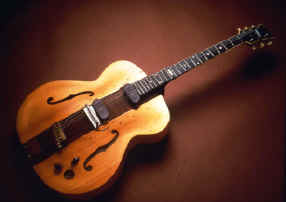
During the 1930s, inventive individuals experimented with guitarbodies
made from a solid piece of wood rather than soundboards over ahollow chamber—partly
for ease of fabrication, partly to preventfeedback.
One of the most prominent innovators was Les Paul. He made this guitar by taking a
4x4-inch solid block of pine, fitting it with two homemade electronic pickups, and then
gluing on the halves of a hollow-body guitar to make it look slightly more conventional.
Around 1946, Paul took his "log" idea to Gibson. Although the company did not
use his design as a prototype, it did work with him and use his name to promote its first
line of solid-body guitars in the 1950s.
Rickenbacker Electro Hawaiian, the
Frying Pan
Electro String Instrument Corporation
Los Angeles, California
Around 1931

Crafted from a single piece of wood, this lap-steel guitar was the
prototype for a cast-aluminum model nicknamed the Frying Pan. The first commercially
successful electric guitar, its electromagnetic pickup is essentially the technology used
on all electric guitars today.
Working for Adolph Rickenbacker, George Beauchamp filed his first U.S. patent application
for the Frying Pan in 1932, shortly before the guitar went into commercial production. A
second, greatly revised application was submitted in 1934.
Although the Frying Pan was already on the market, two successive patent examiners
questioned whether the instrument was "operative."To prove that it was, Adolph
Rickenbacker sent several guitarists to perform for the examiners at the Patent Office in
Washington, D.C.
After many such delays, the patent was finally granted in 1937. By that time, though,
other inventors had developed and marketed electric guitars of their own.
Fender Stratocaster
Fender Electric Instrument Company
Fullerton, California
1954
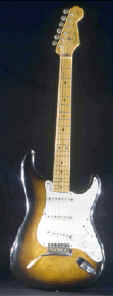
The Stratocaster is arguably the most successful and influential electric
guitar ever produced. It is easily identified by its double cutaways, contoured body, and
three pickups. It also features Fender's vibrato or tremolo system that allows players to
raise or lower the pitch of the strings. In the hands of Buddy Holly, Jimi Hendrix, Buddy
Guy, Eric Clapton, Bonnie Raitt, and many others, the "Strat" has become an
American icon.Bearing serial number 0100, this particular
instrument was probably the first Strat to be shipped for retail sale. It features the
standard two-tone sunburst finish used on early Fender
models.
Fender Precision Bass
Fender Electric Instrument Company
Fullerton, California
1955-56
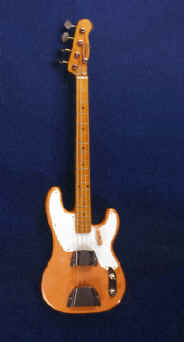
Leo Fender revolutionized the music world with his 1951 electric Precision
Bass, and guitarist Monk Montgomery is credited with making the instrument a musical
sensation. Although there were earlier stand-up electric basses, the "P Bass"
was the first to be played like a standard guitar. It was also the first guitar to have
the
distinctive double cutaways.
By far the most famous and popular electric bass ever made, its name is often used
generically for any electric bass guitar. This model is finished in shell pink, a very
popular custom color of the time.
Fender Jazzmaster
Fender Electric Instrument Company
Fullerton, California
1958
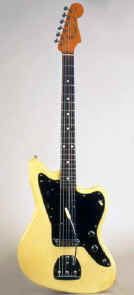
This is a prototype of Fender's Jazzmaster model that was introduced as
the new top-of-the-line guitar in 1958. It was the first guitar to have an asymmetrical
waist and to feature a switch allowing quick changes between rhythm and lead tones.
Fender was attempting to market the instrument to jazz musicians, thus the name. Instead,
it became the guitar of choice for surf bands like the Beach Boys.
Gibson Les Paul Standard or Sunburst
Gibson Inc.
Kalamazoo, Michigan
1959
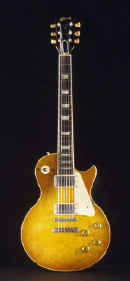
After its introduction in 1952, Gibson's Les Paul model went through a variety of
modifications that culminated in the classic Standard, or Sunburst, in 1958. Its maple cap
on a solid mahogany body and the newly perfected twin-coil humbucking pickups produce a
sound that is highly suitable for rock music.
Famous players like Jimmy Page, Jeff Beck, and Duane Allman helped this guitar become one
of the most popular ever. Les Paul Standards dating from 1958-1960 are among the most
sought-after guitars on the vintage market.
Fender Broadcaster with Amplifier
Fender Electric Instrument Company
Fullerton, California
1950
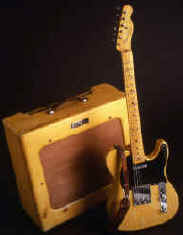
The Broadcaster, Fender's first mass-produced solid-body electric guitar, initially was
derided by competitors as too simple and lacking in craftsmanship. Yet everything about
its patented practical design, such as the bolt-on neck, was optimal for production in
large quantities.
This guitar, serial number 27, was one of the first Broadcasters sold. In 1951, due to a
trademark infringement claim, the model's name was changed to Telecaster in honor of
another popular invention—television.
The many famous artists who have played the Telecaster, such as Jimmy Bryant, Buck Owens,
Keith Richards, and Bruce Springsteen, propelled it to the status of a classic.
Gretsch 6120 Chet Atkins
Fred Gretsch Manufacturing Company
Brooklyn, New York
1959
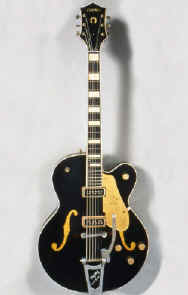
Introduced in 1955, the 6120 was co-designed by, and made for, Chet Atkins
to feature his signature style of fingerpicking. The model was also popularized by Eddie
Cochran and Duane Eddy. Like other Gretsch guitar models, the 6120 changed constantly; by
1959 the Bigsby vibrato was added as a standard feature.
This hollow-body electric guitar was Atkins's personal instrument and appeared on the 1961
Chet Atkins' Workshop album cover.
Gretsch White Penguin
Fred Gretsch Manufacturing Company
Brooklyn, New York
1956
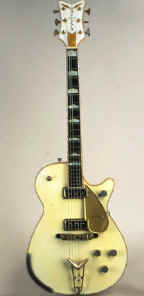
This rare solid-body electric model is one of fewer than 100 manufactured.
Introduced in 1955, the White Penguin never appeared in the Gretsch catalog, despite the
top-of-the-line appointments, like the "Cadillac" tailpiece, for which Gretsch
was known. It was part of the Duo-Jet series and is the solid-body companion of the more
popular electric archtop model, the White Falcon.
Gretsch was best known for its hollow-body electrics, which were favored by the company's
primarily jazz and country music clientele.